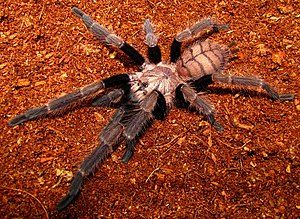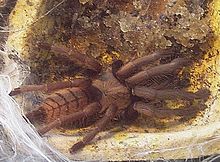Chilobrachys fimbriatus
| Chilobrachys fimbriatus | ||||||||||||
|---|---|---|---|---|---|---|---|---|---|---|---|---|

Chilobrachys fimbriatus , female |
||||||||||||
| Systematics | ||||||||||||
|
||||||||||||
| Scientific name | ||||||||||||
| Chilobrachys fimbriatus | ||||||||||||
| Pocock , 1899 |
Chilobrachys fimbriatus is a spider from the tarantula family(Theraphosidae). The species occurs in western India .
The English trivial name of Chilobrachys fimbriatus is Indian Violet Tarantula and Indian Violet Earthtiger (translated as "Indian violet tarantula" and "Indian violet earth tiger").
features
Chilobrachys fimbriatus reaches a body length of around 50 to 70 millimeters and a leg span of a good 150 millimeters. It is one of the medium-sized tarantula species. While the young animals are uniformly brown in color, the adult spiders have a very contrasting color.
The opisthosoma (abdomen) has a beige-brown basic color and dark lines that form a pattern that is vaguely reminiscent of herringbones . The basic color changes from beige-brown to fawn brown in larger specimens. The two front pairs of legs are darker in color than the two rear ones. The femores (thighs) have a bluish shimmer due to iridescence (refraction of light).
If specimens skinned shortly before are illuminated with a suitable light source, the two front pairs of legs appear blue-gray and the two rear pairs of legs appear red-brown.
Occurrence

Chilobrachys fimbriatus is endemic to the west of India with a correspondingly small distribution area. The species occurs mainly in the Indian state of Goa and also inhabits the west of the state of Maharashtra and the northwest of the state of Karnataka .
habitat
The habitat of Chilobrachys fimbriatus is formed by the tropical areas there, which are influenced by the monsoon . The species is just as insensitive to dry times as it is to times of high humidity. In their habitat, the spider prefers to stay close to the ground, depending on its lifestyle. Chilobrachys fimbriatus shares its habitat with the tarantula species Thrigmopoeus truculentus .
Threat and protection
The stocks of Chilobrachys fimbriatus are not recorded by the IUCN , which means that a precise analysis of possible threats to the species is not possible. It is feared, however, that the sometimes massive imports of specimens, which are taken from nature for the pet trade (see section " Terraristics "), could drastically minimize the population of the species, not least because of its small distribution area.
Way of life

Chilobrachys fimbriatus is counted among the ground-dwelling tarantulas and this species also digs underground tubes that are vertical or horizontal here and serve as the spider's abode. These residential tubes are also lined with a residential web . In this species, young animals in particular are very eager to dig, while the adult spiders dig less and instead strongly spin over their living tubes.
Like all tarantulas, Chilobrachys fimbriatus is nocturnal and spends the day in the tube, while in the evening in front of the tube entrance.
Hunting behavior and range of prey
Like almost all spiders, the predatory species Chilobrachys fimbriatus hunts, as is usual for tarantulas, as a prey hunter and tracks down prey with the help of their sense of vibration, a perception recorded by sensilla (sensory hair). According to its way of life, it lurks for prey at the entrance of its living tube, especially at night. If such a thing comes within range, the spider rushes on it and puts it out of action with a poisonous bite.
As with most tarantulas, the prey spectrum of Chilobrachys fimbriatus includes other invertebrates as well as smaller vertebrates , including reptiles , amphibians or rodents in suitable sizes.
Defense behavior and bite accidents
Chilobrachys fimbriatus is one of the more defensive tarantulas and tries to escape to their shelter in the event of disturbances, e.g. when encounters with possible predators (predators), but does not shy away from a direct defense and announces an attack with the threatening gesture typical for tarantulas who erects the spider, raises the pedipalps (transformed extremities) and the first pair of legs and spreads the chelicerae (jaw claws). If the attacker approaches the spider nonetheless, it hits the attacker three to four times with its raised extremities and defends itself in distress with a poison bite.
Like almost all tarantulas in the Old World and in contrast to most of the New World , Chilobrachys fimbriatus does not have any stinging hairs and therefore cannot defend itself by bombarding it with shed stinging hairs.
There have also been reports of human bites caused by specimens of Chilobrachys fimbriatus . The species' bite is considered quite painful, depending on the area of the body that was bitten by the spider and the amount of venom administered. Scientific analyzes of the toxin (poison) of the species and their toxicity (poisonous effect) are not available.
Life cycle and phenology
The life cycle of Chilobrachys fimbriatus is divided into several phases. The species does not have a uniform phenology (activity according to the seasons) and is accordingly active all year round.
Reproduction
The reproductive behavior of Chilobrachys fimbriatus is similar to that of other tarantulas. The actual mating is mostly peaceful, although the female can occasionally behave aggressively towards the male. Mating takes a long time compared to other tarantulas and can occasionally last 30 to 60 minutes. The male introduces his two bulbi (male sexual organs) alternately into the epigyne (female sexual organ) of the female before both sexual partners separate from each other.
The young animals lay eggs and grow up

Two to three months after mating, the female starts making an egg cocoon , which can contain 250 to 300 eggs. In captivity, the hatching of the young can be observed about nine weeks after the egg cocoon has been made, depending on the housing conditions. The young of Chilobrachys fimbriatus grow up comparatively quickly, so males are sexually mature after about two and females after two and a half years.
Life expectancy
The life expectancy of the female of Chilobrachys fimbriatus is a good 20 to 25 years and of the male about five years, which makes the species one of the more long-lived tarantulas. The life expectancy of the males in particular is high compared to that of the males of other species in this family.
Terrariums
Like many tarantulas, Chilobrachys fimbriatus is often kept as a pet in terrariums . This can be explained by the distinctive appearance of the species and its longevity. Compared to some other tarantulas, it is offered in stores in many places and is therefore easy to buy. Furthermore, due to its natural range, which is influenced by the monsoons , the species can tolerate a high degree of variability in temperatures and humidity, which makes keeping it easier.
For a successful keeping, due to the digging lifestyle, a correspondingly deep and digging underground is required. A prefabricated hiding place can also be offered. Before buying one or more specimens of Chilobrachys fimbriatus , one should be aware of the high level of preparedness, including their hectic nature. Furthermore, you can hardly see the spider during the day due to its nocturnal way of life.
Like other tarantulas, specimens of Chilobrachys fimbriatus are not infrequently taken from nature and illegally get to other continents, which can threaten the natural populations of the species, not least because of its small area of occurrence (see section " Threat and Protection ").
Systematics
The first descriptor , the British arachnologist Reginald Innes Pocock , gave the species the name Chilobrachys fimbriatus in his first description in 1899 . The species Ischnocolus decoratus was described by the Indian arachnologist Benoy Krishna Tikader in 1977 and placed in the tarantula genus Ischnocolus . In 2009, however, the Indian arachnologist Manju Siliwal found that it was not a new species, but Chilobrachys fimbriatus , so Ischnocolus decoratus was synonymous with Chilobrachys fimbriatus .
gallery
Egg cocoon taken from a female.
Prelarvae ("egg with legs") shortly after hatching
Individual evidence
- ↑ a b c d e f g h i j k Chilobrachys fimbriatus (Pocock, 1899) at Arachnophilia.de, accessed on May 4, 2020.
- ↑ a b c d e Chilobrachys fimbriatus (Pocock, 1899) at Eckis Vogelspinnenzucht, accessed on May 4, 2020.
- ↑ a b c d e f g h i j k Chilobrachys fimbriatus (Pocock, 1899) from Theraphosidae (Dutch), accessed on May 4, 2020.
- ↑ Chilobrachys fimbriatus (Pocock, 1899) at Global Biodiversity Information Facility , accessed on May 4, 2020.
- ↑ Chilobrachys fimbriatus (Pocock, 1899) in the WSC World Spider Catalog , accessed May 4, 2020.
literature
- Hans W. Kothe: tarantulas. 1st edition, Franckh-Kosmos, Stuttgart 2003, ISBN 3-4400-9367-0 .
- Volker von Wirth: tarantulas. 1st edition. Gräfe and Unzer, Munich 2011, ISBN 978-3-8338-2151-6 .
- Manju Siliwal: Revalidating the taxonomic position of the Indian Ischnocolus spp. (Araneae: Theraphosidae) , Journal of Threatened Taxa 1, 10th volume, 2009, pp. 533-534.
Web links
- Chilobrachys fimbriatus in the World Spider Catalog
- Chilobrachys fimbriatus (Pocock, 1899) at Tarantupedia
- Chilobrachys fimbriatus (Pocock, 1899) at Global Biodiversity Information Facility
- Chilobrachys fimbriatus (Pocock, 1899) at Arachnophilia.de
- Chilobrachys fimbriatus (Pocock, 1899) at Eckis tarantula breeding
- Chilobrachys fimbriatus (Pocock, 1899) in Theraphosidae (Dutch)






